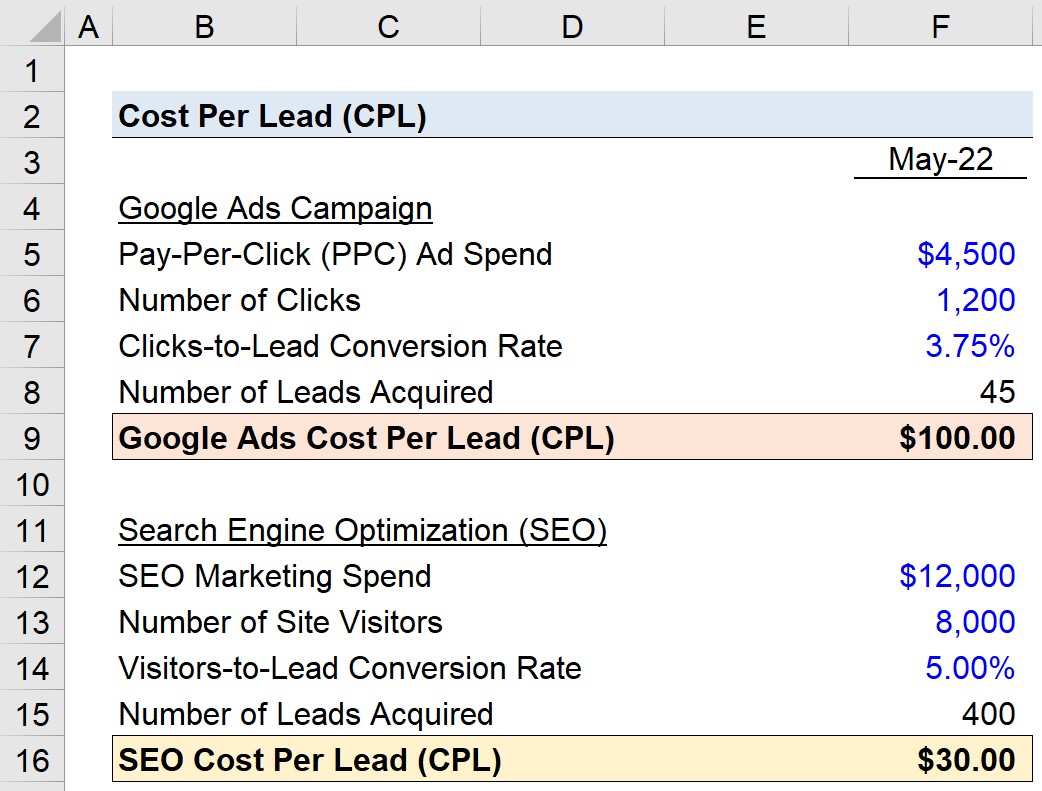What is Cost Per Lead?
The Cost Per Lead (CPL) is the dollar amount spent on ad and marketing campaigns to acquire a new lead, i.e. a potential customer.
CPL is tracked as part of a company’s lead (or demand) generation efforts and is typically segmented by each separate social media, email marketing, or ad campaign.

How to Calculate Cost Per Lead (CPL)
The cost per lead (CPL) refers to the amount spent to acquire a new lead, which is a potential customer that enters a company’s pipeline and can potentially convert into a paying customer.
CPL is most often tracked on the basis of different time periods (e.g. by month, by quarter, by year) and is separated by campaign type, marketing channel, and end markets to determine which strategy is most efficient.
Using the insights derived from the CPL, more capital should be allocated to the strategies with the highest return on investment (ROI).
By evaluating the CPL per channel rather than consolidating all channels, a company can better optimize its ad and marketing campaign strategies to achieve its current objectives.
More specifically, the goal for the vast majority of startups should be to maximize the number of potential leads that enter their sales pipeline, while keeping their CPL to a minimum.
The reduction of CPL while increasing the number of leads within the pipeline should theoretically cause a company’s revenue and profit margins to increase – barring unusual circumstances.
Cost Per Lead Formula
Calculating the cost per lead (CPL) metric involves dividing the expenses attributable to marketing campaigns by the number of acquired leads.
For example, if a startup spent $10,000 on social media ads in a month and acquired 200 new leads, the cost per lead (CPL) is $50.
- Cost Per Lead (CPL) = $10,000 ÷ 200 = $50.00
Cost Per Lead (CPL) vs. Customer Acquisition Cost (CAC)
The cost per lead (CPL) and customer acquisition cost (CAC) may share some similarities, but the two are very different metrics.
The difference between CPL and CAC comes down to the difference between a lead and a customer:
- Lead → A potential customer that has expressed interest in purchasing a company’s products/services.
- Customer → A lead that has successfully converted into a paying customer.
CPL measures the cost of acquiring a lead, whereas CAC is the amount it costs on average to acquire a paying customer.
CPL indicates how efficiently a company can potentially expand its customer base but hones in on the number of leads obtained rather than the number of customers acquired.
The relationship between the CPL and CAC is that the more it costs to acquire a lead, the higher the CAC is likely to be (and vice versa).
Cost Per Lead Calculator
We’ll now move to a modeling exercise, which you can access by filling out the form below.
1. CPL Marketing Campaign Assumptions
Suppose a B2B startup is attempting to manage its marketing budget.
In May 2022, the startup ran two lead-generation campaigns:
- Google Ads
- Search Engine Optimization (SEO)
Google Ads falls under the pay-per-click (PPC) marketing channel, and the startup participates in targeted ad placement on relevant keywords that potential leads often search.
Conversely, SEO refers to the startup’s spending related to content production on their blog, where the site traffic being generated is organic.
For the most part, SEO is viewed as the more cost-effective method of obtaining leads, while PPC models are lower margin.
In this case, the startup defines a lead as a user that fills out a form requesting more information and agrees to be contacted by a sales representative.
2. Cost Per Lead Calculation Example (CPL)
In May, the total monthly spending on PPC ads was $4,500, which brought in 1,200 clicks at a 3.75% clicks-to-lead conversion rate.
- Pay-Per-Click (PPC) Ad Spend = $4,500
- Number of Clicks = 1,200
- Clicks-to-Lead Conversion Rate = 3.75%
- Number of Leads Acquired = 45
On the SEO side, the total marketing spending related to its blog was $12,000, while the number of site visitors was 8,000 at a 5.0% visitors-to-lead conversion rate.
- SEO Marketing Spend = $12,000
- Number of Site Visitors = 8,000
- Visitors-to-Lead Conversion Rate = 5.00%
- Number of Leads Acquired = 400
The cost per lead (CPL) can be calculated for both marketing channels by dividing the campaign spending by the number of new leads acquired.
- Google Ads Cost Per Lead (CPL) = $100.00
- SEO Cost Per Lead (CPL) = $30.00
The average CPL and optimal spending vary by the industry and are affected by numerous factors, but our example supports the notion that SEO tends to lead to higher conversion rates with higher traffic potential.

Everything You Need To Master Financial Modeling
Enroll in The Premium Package: Learn Financial Statement Modeling, DCF, M&A, LBO and Comps. The same training program used at top investment banks.
Enroll Today





